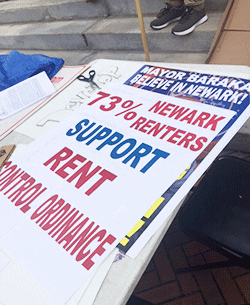
Photo by Keli Tianga
This Tuesday, advocates took to the microphone on the steps of Newark City Hall and spoke passionately about the city they love and their right to live there without threat of displacement. Passersby looked up at signs that called out city council members by name, demanding they take action. Some walked up to the organizers, dressed in black or green t-shirts, and asked if housing was available or if someone had a housing list they could get on. They mention homelessness, tenuous living arrangements, or substandard living conditions.
The scene is a snapshot of housing conditions in Newark and other cities around the country—ones that don’t want to go the way of Brooklyn, San Francisco, and Jersey City, where housing costs for longstanding residents have become untenable. Nationally, Right to the City Alliance and locally, groups gathered here like Tenants Together, Housing 4 Newark, People’s Organization for Progress, and Greater Newark HUD Tenants Coalition have been rallying, demonstrating, and speaking out all week leading up to today’s National Renters Day of Action. This demonstration will last 36-hours, and community members are calling for city leadership to act on their constituents behalf against gentrification and displacement.
Real estate investors and developers who knew these boom days would eventually come are poised to cash in on Newark. The finishing touches are being put on a Whole Foods market downtown, a new hotel, and market-rate apartment buildings are growing in number, including 1 bedroom units in one that Drew Curtis, director of Community Development and Environmental Justice at Ironbound Community Corporation says will go for upwards of $2,000 per month, just blocks from City Hall.
In poor and historically disinvested cities like Newark, new development is rare for existing residents. Although Newark has some of the region’s largest cultural and academic institutions, such as Rutgers University’s Newark campus, the NJ Performing Arts Center, and Seton Hall Law School, it is no exception. The major issues for residents here are affordability, stability, and housing quality and safety. One organizer pointed out another who hasn’t had pest control visit his building in the 16 months he’s lived there, and is now being forced to contact Code Enforcement. Felicia Alston-Singleton, a tenant advocate with Greater Newark HUD Tenants Coalition, says that in her estimation, only about 15 percent of the city’s renters know their rights as tenants. “Your lease should be next to your bible—that’s how important it is,” she says. Alston-Singleton began advocating for herself and representing herself in court over three years ago when she was a victim of an unscrupulous landlord, and began studying the NJ Tenants Rights handbook. As people walk up looking for help, she lets them know that they are there to “educate, empower, and strengthen the community.”
Curtis of Ironbound CC says their effort is multi-pronged, because the fabric of Newark is being threatened for all residents, from many angles. “We’re protecting five or six units at a time, they’re demolishing dozens at a time,” he says. This coalition is made up of tenant organizations in big buildings and public housing developments, subsidized housing residents, public housing residents, private housing residents, and homeowners. They have been working with the mayor, Ras Baraka, on preserving Newark’s already strong rent control ordinance, maintaining Newark’s dwindling public and private federally subsidized housing, and creating a strong inclusionary zoning ordinance. The latter two are increasingly connected, because as subsidized housing stock decreases in Newark, inclusionary housing becomes a larger tool in the creation of affordable housing. Advocates want to lower the minimum number of total units to 20 from 30 for new buildings to have inclusionary housing requirements. They also want to remove the exclusion of “substantial rehab” from the inclusionary policy, which enables existing structures undergoing a gut rehab to be exempt.
When faced with the question of whether inclusionary zoning disincentivizes some development, Curtis is confident that the market is already here, and in fact, he fears a rush on new development permits and construction before an ordinance is passed in order to avoid the new requirements.
Renters make up 73 percent of the city’s population, and they’re feeling looming pressure. John Goldstein, a Newark resident and founder of Coalitions, Campaigns, and Community Benefits, lives only blocks away in a rent controlled apartment in the city’s Ironbound section. He fears his landlord will sell the 16-unit building he lives in, at which time his rent control protection, which doesn’t transfer to a property’s new owner, will end. “The neighborhood works the way a neighborhood should: there are small businesses owned by people who live in the neighborhood, so money is recycled within the community, there are parks and pick-up soccer games. That’s being lost.”
The National Renters Day of Action demands:
-
- A national rent freeze, a national livable rent and livable wage for all
- A freeze on all unjust evictions
- Community control over land and housing
- The right of all tenants to organize and bargain collectively with landlords without fear of discrimination, retaliation, or eviction





Comments